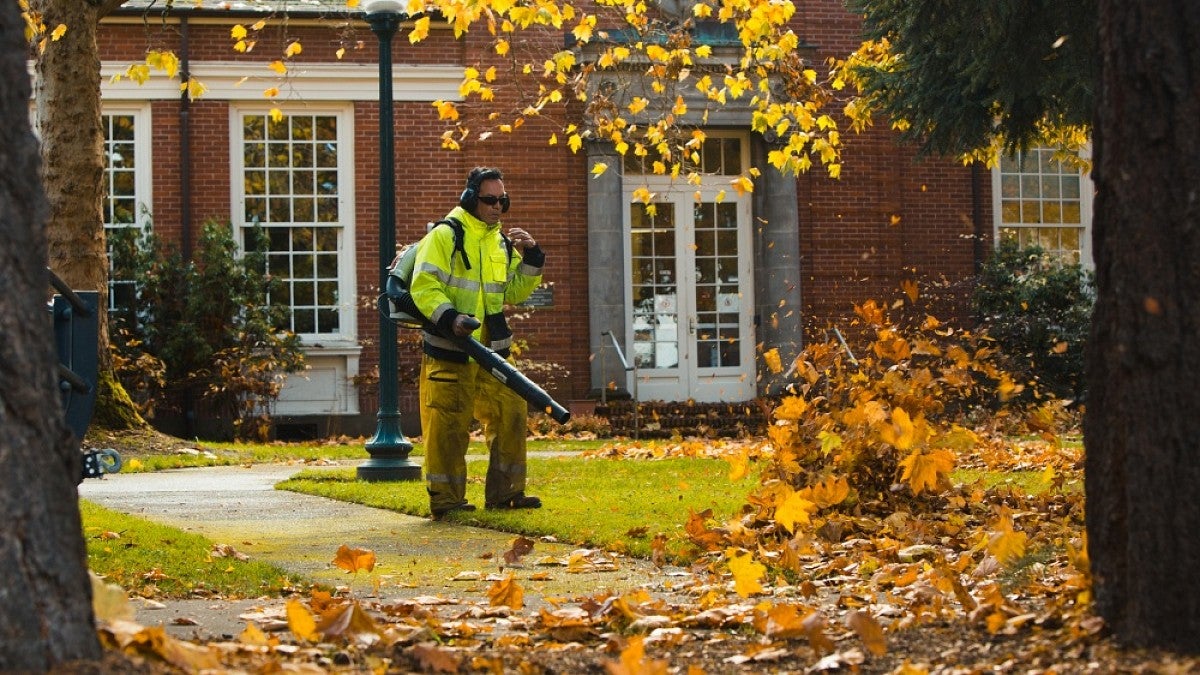Each fall, tons of leaves rain down on the UO campus, blanketing the ground in fiery colors. The leaves can conceal crosswalks, clog drains and coat sidewalks with slippery sludge if left untouched.
So for two-three months each year, Facilities Services deploys groundskeepers armed with leaf blowers, rakes, tractors and trucks to focus almost exclusively on the battle against the leaves.
Campus is divided into 10 zones. There are 11 full-time groundkeepers and two to five student workers.
“What we do during leaf season is we split the crew up and we have two-person teams. So all the workers that we have are making piles of leaves throughout the week,” said Rodney Madison, UO landscape coordinator. “It’s about 80 percent of what the groundskeepers do on a daily basis: gather leaves.”
Scott Tedder, a UO groundskeeper, spends his days with a leaf blower strapped to his back, blowing waves of red, orange, yellow and brown leaves into piles.
“I run my blower probably four or five hours out of the day right now,” said Tedder, while directing pedestrians around a leaf-grabbing clamshell tractor in the parking lot east of Bean Hall. “My iPhone stays on me and says I do like six, seven, eight miles a day. Just back and forth.”
The clamshell tractor pinched giant loads of wet leaves, hauled out of East Bean’s courtyard by hand, and dropped them into the back of a white Facilities Services truck.
Tedder explained the groundskeepers’ priority areas for leaf-clearing.
“There’s the concrete, the high-traffic areas where kids walk to school, and then also keeping our storm drains clear because campus can flood,” he said. “We actually have a map that has critical storm drains. There are maybe about 60 on the map that say ‘keep very vigilant on this,’ because if we don’t, things can flood and this could go into buildings.”
Across Franklin Boulevard, on the Facilities Services lot, are three mounds. The first is one of fresh leaves and sticks. The second looks like it’s made of bark. The third looks like dark, rich soil.
After being corralled into piles and loaded onto trucks, the leaves journey across Franklin Boulevard and are dumped into the first massive mound. The mound grows all year long as leaves, grass, plant clippings and yard debris are added. In early October, in preparation for a new load of autumn leaves, the first pile is ground into the second pile.
“It’s ground up and made into a pile of mulch,” explained Madison. “It sits there and decomposes and cooks. It gets really hot inside, almost to the point of catching fire inside. We call it a ‘hot pile’ because it’s decomposing and it generates heat that way.”
Every year around 500 cubic yards of mulch — weighing around 150 tons — are produced. Mulch is used around campus to improve the soil around plants and to prevent weeds from growing.
“We never have to buy any mulch for campus,” said Madison. “We actually generate more than we can use.”
Each year, the mulch that isn’t used is ground a second time. The end product is the third pile.
“This is more of a planting mix because it’s decomposed even further,” said Madison.
For Phillip Carroll, previously a UO groundskeeper and now landscape and grounds manager, the beauty of the university’s campus makes the hard work worthwhile. The trees were what drew him to the UO in the first place.
“I saw campus and thought to myself, ‘Man, I want to be a part of that.’ Our tree collection is incredible,” Carroll said.
“We have such a great crew, and they accomplish so much that I’d say the best part is just kind of working with them and saying, ‘You know what needs to be done?’, or ‘Hey, there’s this new problem we could fix’, and getting it done so you can kind of see what we’ve accomplished and appreciate it.”
A lot of consideration goes into the leaf-collecting effort. Critical storm drains must be watched. In certain areas, leaves can be left in their tree beds to enrich the soil directly. To minimize the noise problem of the leaf blowers and tractors, groundskeepers start their work directly on campus in the early morning and try to move to the periphery when classes start.
“It’s a lot of work. This time of year, the weather is not always very good, so we’re out working and it doesn’t matter if it’s raining or blowing or snowing. We’re out working. We’re outdoor people, and we like what we do. We just don’t always like what we do,” Madison said with a chuckle.
—By Sarah Eddy, University Communications


